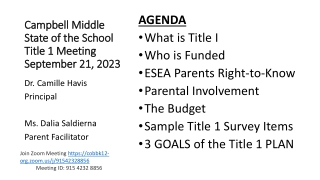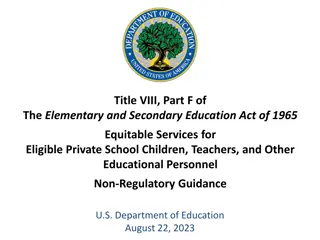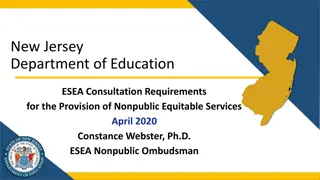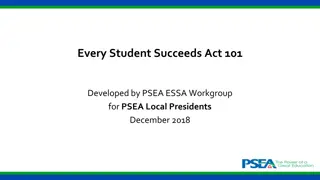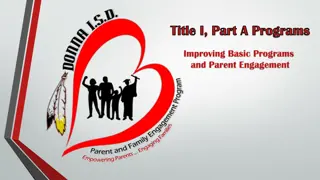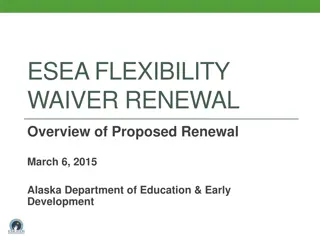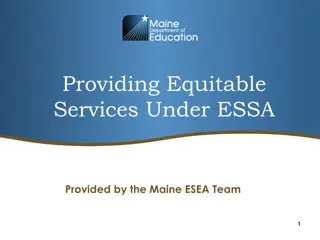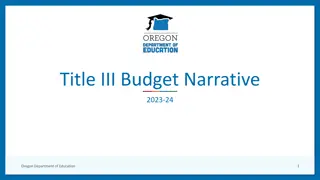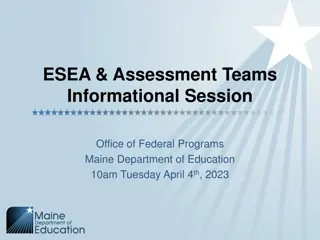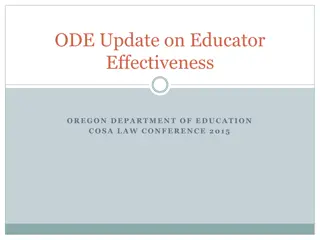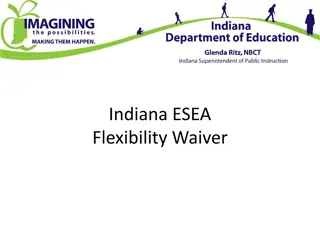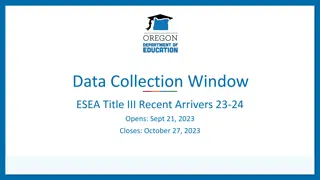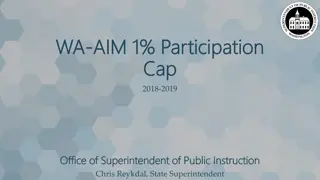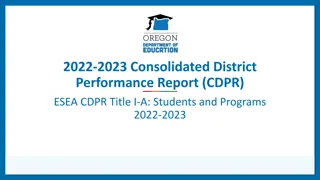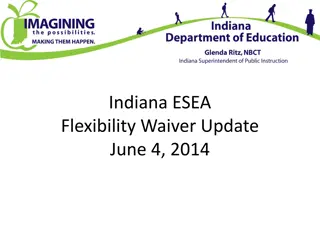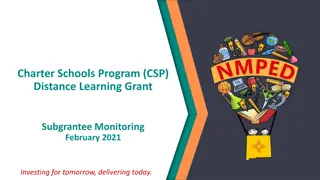Understanding Title I Program and Parental Involvement in Education
Explore the details of the Title I program under ESEA, funding allocations, parental involvement significance, and its impact on student achievement. Learn about school-wide and targeted assistance programs, parental rights to know, and the benefits of strong collaboration between schools, families,
1 views • 48 slides
Understanding Title I Program in Education
The Title I program is a key component of the Elementary and Secondary Education Act (ESEA) aimed at providing supplemental support to schools with the goal of ensuring a higher quality of education for every child. This assistance program, funded by the U.S. Department of Education, supports school
7 views • 18 slides
Equitable Services for Private School Children and Teachers
The Elementary and Secondary Education Act of 1965, specifically Title VIII, Part F, outlines the provision of equitable services for eligible private school children, teachers, and other educational personnel. This non-regulatory guidance emphasizes the importance of ensuring fairness and support f
4 views • 32 slides
New Jersey Department of Education ESEA Consultation Requirements
The New Jersey Department of Education outlines the roles and responsibilities for providing equitable services to nonpublic schools under ESEA guidelines. This includes the responsibilities of the State Education Agency, Local Districts, and Nonpublic Schools in ensuring fair access to educational
0 views • 34 slides
Understanding the Every Student Succeeds Act (ESSA) of 2015
The Every Student Succeeds Act (ESSA) is a civil rights law that stems from the 1965 Elementary and Secondary Education Act (ESEA) focusing on equity, transparency, stakeholder engagement, and accountability at the school level. ESSA requires states to have college and career readiness standards, as
0 views • 10 slides
Enhancing Student Achievement through Title I Programs
Title I, Part A programs at Donna ISD focus on improving basic education programs and increasing parent engagement. Schools receiving funding under ESEA work on extensive planning, ensuring highly qualified staff, providing information to parents, and involving parents in campus decision-making to e
0 views • 10 slides
Nebraska Education Standards Implementation Timeline
The timeline outlines the process of aligning the Common Core State Standards with Nebraska's language arts and mathematics standards, involving studies, reviews, revisions, and approvals by the State Board of Education. Implementation is expected to be completed by spring 2014, with school district
0 views • 18 slides
Effective Monitoring Practices for Federal Programs in Education
Effective monitoring practices for federal education programs, such as ESEA Title I-A, II-A, IV-A, V-B, McKinney-Vento, Foster Care, and Equitable Services to Private Schools by the Oregon Department of Education. The monitoring process involves desk monitoring and on-site visits to ensure education
0 views • 23 slides
Alaska ESEA Flexibility Waiver Renewal Overview
Alaska Department of Education & Early Development is proposing a renewal for the ESEA Flexibility Waiver, focusing on key principles such as college and career-ready expectations for all students, state-developed differentiated accountability, and support for effective instruction and leadership. T
0 views • 19 slides
Equitable Services Requirements and Guidelines under ESSA
Equitable Services Requirements and guidelines under ESSA outline the responsibilities of education officials, ombudsman, and private school administrators to ensure fair distribution of federal funds. The ESEA Team in Maine works to uphold Title I, Part A, Migrant Education, Teacher Quality, Englis
0 views • 56 slides
Education Act of 1965 and Equitable Services for Private School Students
The Elementary and Secondary Education Act (ESEA) of 1965, as amended by the Every Student Succeeds Act in 2015, ensures equitable participation of private school students and teachers in federal education programs. The Office of Non-Public Education (ONPE) oversees this initiative, providing resour
0 views • 30 slides
Budget Narrative for Title III Grants in Oregon Education 2023-24
This budget narrative outlines the goals of Title III grants for the Oregon Department of Education, focusing on aiding English learners in attaining language proficiency and academic achievement. It emphasizes the importance of Supplement not Supplant regulations to ensure proper fund allocation an
0 views • 38 slides
Maine Department of Education ESEA & Assessment Teams Information Session
Maine Department of Education is hosting an informational session introducing the ESEA & Assessment Teams. The session covers topics like assessment goals, performance reports, and growth goals for math and reading. It also provides insights on the Maine Through Year Assessment and the use of MAP Gr
0 views • 20 slides
Oregon Department of Education Update on Educator Effectiveness - 2015 Conference Highlights
Explore key topics from the 2015 COSA Law Conference, including educator effectiveness updates, student growth percentiles, norms for collaboration, learning objectives, ESEA waiver insights, and more.
0 views • 37 slides
Understanding Indiana's ESEA Flexibility Waiver
Indiana's ESEA Flexibility Waiver, part of cohort 1, provided flexibility in utilizing the state's own accountability system, allocating Title I funds, and improving academic performance at state and local levels. The waiver aimed to enhance educational outcomes, address achievement gaps, promote eq
0 views • 122 slides
Guide for Reporting Recent Arrivers in ESEA Title III 2023-24
Comprehensive information on reporting recent arrivers in education under ESEA Title III 2023-24, including definitions, eligibility criteria, required data, and guidelines. Learn who qualifies, what data to collect, and the importance of reporting foreign exchange students meeting the criteria.
0 views • 38 slides
Understanding the 1% Participation Cap in Education
Explanation of the 1% Participation Cap in education, focusing on identifying the right students for the WA-AIM assessment. Discusses ESEA requirements, district justifications, and the assessment criteria for students with significant cognitive disabilities. Emphasizes the need for oversight and pu
0 views • 16 slides
2022-2023 Consolidated District Performance Report (CDPR) Overview
Gain insights into the 2022-2023 Consolidated District Performance Report (CDPR) for ESEA CDPR Title I-A regarding students and programs. Discover important data collection details, resource materials, validations, and FAQs provided by the Oregon Department of Education. Utilize the CDPR Title I-A V
0 views • 38 slides
Enhancing Educational Stability for Children in Foster Care
This detailed walkthrough of federal non-regulatory guidance focuses on ensuring stability for children in foster care, with a particular emphasis on educational stability under ESEA and ESSA provisions. It covers key aspects such as the school of origin, collaboration between SEAs, LEAs, and child
0 views • 26 slides
Indiana ESEA Flexibility Waiver Update Summary
Indiana ESEA Flexibility Waiver update for June 4, 2014, highlights areas not meeting expectations, timelines for submissions, waiver components involving subject matter experts, and specific calls related to teacher evaluation, monitoring, assessments, standards transition, school focus, technical
0 views • 45 slides
Investing in Tomorrow: Charter Schools Program Distance Learning Grant Monitoring
The Charter Schools Program (CSP) Distance Learning Grant Subgrantee Monitoring for February 2021 outlines the program period, budget adjustments, allowable expenditures, and quarterly reporting requirements. It highlights the guidelines, subaward notifications, and procedures related to the federal
0 views • 17 slides
ESEA Title III Recent Arrivers Data Collection Window 2022-23
The ESEA Title III Recent Arrivers Data Collection Window for the academic year 2022-23 is open from September 22 to October 28, 2022. It aims to collect information on recent arrivers, defined as aged 3-21, not born in the US or its territories, and educated in the US for less than three cumulative
0 views • 38 slides
